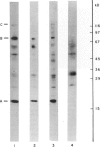Abstract
Anticentromere antibodies (ACA) present in a high percentage of patients with complete or incomplete CREST scleroderma, and which are presently used in the diagnosis of this disease, also appear in some primary Raynaud's phenomenon patients. Three principal centromeric antigens, CENP-A, CENP-B and CENP-C, have been described as reacting with the sera of these individuals. We attempt to determine whether or not a correlation between the presence of ACA and serum reactivity against one or more of these peptides could be established, and have observed that CENP-A, but not CENP-B or CENP-C, is specifically recognized by all patients sera tested. The fact that this reactivity is clearly detectable at very high serum dilutions, thus eliminating other non-specific interference, suggests that anti-CENP-A activity might be useful in the diagnosis of patients with CREST-associated Raynaud's phenomenon.
Full text
PDF




Images in this article
Selected References
These references are in PubMed. This may not be the complete list of references from this article.
- Bernstein R. M., Callender M. E., Neuberger J. M., Hughes G. R., Williams R. Anticentromere antibody in primary biliary cirrhosis. Ann Rheum Dis. 1982 Dec;41(6):612–614. doi: 10.1136/ard.41.6.612. [DOI] [PMC free article] [PubMed] [Google Scholar]
- Catoggio L. J., Bernstein R. M., Black C. M., Hughes G. R., Maddison P. J. Serological markers in progressive systemic sclerosis: clinical correlations. Ann Rheum Dis. 1983 Feb;42(1):23–27. doi: 10.1136/ard.42.1.23. [DOI] [PMC free article] [PubMed] [Google Scholar]
- Earnshaw W. C., Rothfield N. Identification of a family of human centromere proteins using autoimmune sera from patients with scleroderma. Chromosoma. 1985;91(3-4):313–321. doi: 10.1007/BF00328227. [DOI] [PubMed] [Google Scholar]
- Earnshaw W., Bordwell B., Marino C., Rothfield N. Three human chromosomal autoantigens are recognized by sera from patients with anti-centromere antibodies. J Clin Invest. 1986 Feb;77(2):426–430. doi: 10.1172/JCI112320. [DOI] [PMC free article] [PubMed] [Google Scholar]
- Epstein A. L., Kaplan H. S. Feeder layer and nutritional requirements for the establishment and cloning of human malignant lymphoma cell lines. Cancer Res. 1979 May;39(5):1748–1759. [PubMed] [Google Scholar]
- Fritzler M. J., Kinsella T. D. The CREST syndrome: a distinct serologic entity with anticentromere antibodies. Am J Med. 1980 Oct;69(4):520–526. doi: 10.1016/0002-9343(80)90462-3. [DOI] [PubMed] [Google Scholar]
- Guldner H. H., Lakomek H. J., Bautz F. A. Human anti-centromere sera recognise a 19.5 kD non-histone chromosomal protein from HeLa cells. Clin Exp Immunol. 1984 Oct;58(1):13–20. [PMC free article] [PubMed] [Google Scholar]
- Kallenberg C. G., Pastoor G. W., Wouda A. A., The T. H. Antinuclear antibodies in patients with Raynaud's phenomenon: clinical significance of anticentromere antibodies. Ann Rheum Dis. 1982 Aug;41(4):382–387. doi: 10.1136/ard.41.4.382. [DOI] [PMC free article] [PubMed] [Google Scholar]
- Laemmli U. K. Cleavage of structural proteins during the assembly of the head of bacteriophage T4. Nature. 1970 Aug 15;227(5259):680–685. doi: 10.1038/227680a0. [DOI] [PubMed] [Google Scholar]
- McCarty G. A., Rice J. R., Bembe M. L., Barada F. A., Jr Anticentromere antibody. Clinical Correlations and association with favorable prognosis in patients with scleroderma variants. Arthritis Rheum. 1983 Jan;26(1):1–7. doi: 10.1002/art.1780260101. [DOI] [PubMed] [Google Scholar]
- Seibold J. R., Trontell M. C. Anticentromere antibody and primary pulmonary hypertension. J Rheumatol. 1982 Jul-Aug;9(4):607–609. [PubMed] [Google Scholar]
- Tan E. M., Rodnan G. P., Garcia I., Moroi Y., Fritzler M. J., Peebles C. Diversity of antinuclear antibodies in progressive systemic sclerosis. Anti-centromere antibody and its relationship to CREST syndrome. Arthritis Rheum. 1980 Jun;23(6):617–625. doi: 10.1002/art.1780230602. [DOI] [PubMed] [Google Scholar]
- Towbin H., Staehelin T., Gordon J. Electrophoretic transfer of proteins from polyacrylamide gels to nitrocellulose sheets: procedure and some applications. Proc Natl Acad Sci U S A. 1979 Sep;76(9):4350–4354. doi: 10.1073/pnas.76.9.4350. [DOI] [PMC free article] [PubMed] [Google Scholar]
- Tramposch H. D., Smith C. D., Senecal J. L., Rothfield N. A long-term longitudinal study of anticentromere antibodies. Arthritis Rheum. 1984 Feb;27(2):121–124. doi: 10.1002/art.1780270201. [DOI] [PubMed] [Google Scholar]
- del Mazo J., Martín-Sempere M. J., Kremer L., Avila J. Centromere pattern in different mouse seminiferous tubule cells. Cytogenet Cell Genet. 1986;43(3-4):201–206. doi: 10.1159/000132321. [DOI] [PubMed] [Google Scholar]





